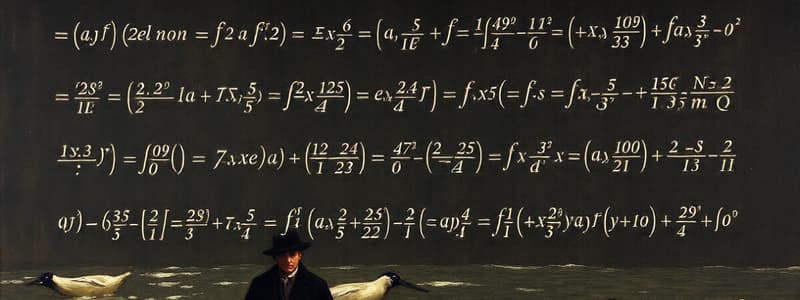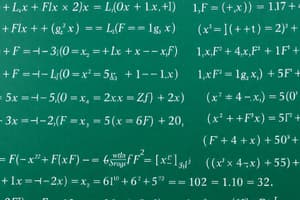Podcast
Questions and Answers
Which of the following describes a polynomial?
Which of the following describes a polynomial?
- An expression with one or multiple terms. (correct)
- A single constant value.
- A ratio of two algebraic expressions.
- An equation that represents a straight line.
What is the standard form of a quadratic equation?
What is the standard form of a quadratic equation?
- ax³ + bx² + cx + d = 0
- ax² + bx + c = 0 (correct)
- ax + b = c
- y = mx + b
Which of the following represents the operation of exponentiation?
Which of the following represents the operation of exponentiation?
- 5 + 3
- 2 × 2
- 6 ÷ 3
- 3² (correct)
What is the greatest degree of the polynomial 4x³ + 3x² - 2x + 1?
What is the greatest degree of the polynomial 4x³ + 3x² - 2x + 1?
What does the slope of a line represent in algebra?
What does the slope of a line represent in algebra?
Which of the following statements about solving two-variable equations is true?
Which of the following statements about solving two-variable equations is true?
Which property is used to simplify the expression a(b + c)?
Which property is used to simplify the expression a(b + c)?
What is the purpose of using inverse operations when solving one-variable equations?
What is the purpose of using inverse operations when solving one-variable equations?
Flashcards are hidden until you start studying
Study Notes
Algebra
-
Definition: Branch of mathematics dealing with symbols and the rules for manipulating those symbols. Represents numbers in formulas and equations.
-
Key Concepts:
- Variables: Symbols (like x, y) representing unknown values.
- Constants: Fixed values that do not change.
- Expressions: Combinations of variables, constants, and operators (e.g., 2x + 3).
- Equations: Statements that two expressions are equal (e.g., 2x + 3 = 7).
-
Operations:
- Addition (+), Subtraction (-), Multiplication (×), Division (÷).
- Exponentiation: Raising numbers to a power (e.g., x²).
-
Types of Algebra:
- Elementary Algebra: Basics of algebra, focusing on solving simple equations and understanding polynomials.
- Abstract Algebra: Studies algebraic structures such as groups, rings, and fields.
- Linear Algebra: Focuses on vector spaces and linear mappings, including matrices and systems of linear equations.
-
Fundamental Principles:
- Order of Operations: PEMDAS/BODMAS (Parentheses, Exponents, Multiplication and Division, Addition and Subtraction).
- Distributive Property: a(b + c) = ab + ac.
- Combining Like Terms: Simplifying expressions by adding/subtracting coefficients of like variables.
-
Solving Equations:
- One-variable equations: Isolate the variable using inverse operations.
- Two-variable equations: Graphically represented as lines in the coordinate plane; solution is the intersection point.
-
Quadratic Equations:
- Standard form: ax² + bx + c = 0.
- Solving methods: Factoring, completing the square, and using the quadratic formula: x = [-b ± √(b² - 4ac)] / (2a).
-
Functions:
- Definition: A relationship between input (x) and output (y).
- Notation: f(x) represents the function in terms of variable x.
- Types: Linear functions (y = mx + b), quadratic functions (y = ax² + bx + c), exponential functions (y = ab^x).
-
Graphing:
- Coordinate Plane: X-axis (horizontal), Y-axis (vertical).
- Plotting Points: (x, y) pairs represent solutions of functions.
- Slope: Rate of change, calculated as rise/run for linear functions.
-
Inequalities:
- Expressions that show the relationship between two values (e.g., x > 5).
- Solutions include ranges of values, represented on a number line or graph.
-
Polynomials:
- Expression with multiple terms (e.g., 4x³ + 3x² - 2x + 1).
- Degree: Highest exponent of the variable.
- Operations: Addition, subtraction, multiplication, and division of polynomials.
-
Applications:
- Used in various fields such as physics, engineering, economics, and statistics to model real-world situations.
-
Tips for Success:
- Practice solving different types of equations and inequalities.
- Familiarize yourself with graphing techniques and interpreting graphs.
- Understand and apply algebraic properties to simplify expressions.
Algebra
- Definition: A branch of mathematics focused on manipulating symbols to represent numbers in formulas and equations.
- Key Concepts:
- Variables: Symbols, like 'x' or 'y,' that stand for unknown values.
- Constants: Fixed values that don't change.
- Expressions: Combinations of variables, constants, and operators, for example, 2x + 3.
- Equations: Statements asserting that two expressions are equal. For instance, 2x + 3 = 7.
- Operations:
- Addition (+), Subtraction (-), Multiplication (×), and Division (÷): Basic arithmetic operations.
- Exponentiation: Raising numbers to a power (e.g., x²).
- Types of Algebra:
- Elementary Algebra: Focuses on understanding basic concepts like solving simple equations and working with polynomials.
- Abstract Algebra: Explores algebraic structures like groups, rings, and fields.
- Linear Algebra: Deals with vector spaces, linear transformations, matrices, and systems of linear equations.
- Fundamental Principles:
- Order of Operations: PEMDAS/BODMAS (Parentheses/Brackets, Exponents, Multiplication and Division, Addition and Subtraction).
- Distributive Property: a(b + c) = ab + ac.
- Combining Like Terms: Simplifying expressions by adding or subtracting coefficients of the same variables.
- Solving Equations:
- One-variable equations: Involve solving for the value of a single variable by using inverse operations.
- Two-variable equations: Represented as lines on a coordinate plane. Their solution is where the lines intersect.
- Quadratic Equations:
- Standard form: ax² + bx + c = 0.
- Solving methods: Factoring, completing the square, and using the quadratic formula: x = [-b ± √(b² - 4ac)] / (2a).
- Functions:
- Definition: A relationship between an input (x) and an output (y).
- Notation: f(x) represents the function in terms of the variable 'x'.
- Types: Linear functions (y = mx + b), quadratic functions (y = ax² + bx + c), and exponential functions (y = ab^x).
- Graphing:
- Coordinate Plane: Consisting of an X-axis (horizontal) and a Y-axis (vertical).
- Plotting Points: (x, y) pairs represent solutions of functions.
- Slope: Indicates the rate of change, calculated as rise/run for linear functions.
- Inequalities:
- Definition: Expressions showing the relationship between two values, using symbols like '>' (greater than), '<' (less than), '≥' (greater than or equal to), or '≤' (less than or equal to), for example, x > 5.
- Solutions: Include a range of values, represented on a number line or graph.
- Polynomials:
- Definition: Expressions with multiple terms, such as 4x³ + 3x² - 2x + 1.
- Degree: The highest exponent of the variable.
- Operations: Addition, subtraction, multiplication, and division of polynomials.
- Applications:
- Used extensively in fields like physics, engineering, economics, and statistics to model real-world situations.
- Tips for Success:
- Practice solving various types of equations and inequalities.
- Familiarize yourself with graphing techniques and interpreting graphs.
- Understand and apply algebraic properties to simplify expressions.
Studying That Suits You
Use AI to generate personalized quizzes and flashcards to suit your learning preferences.




